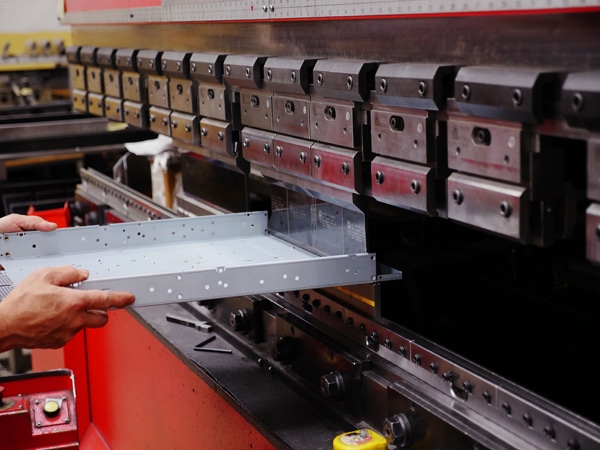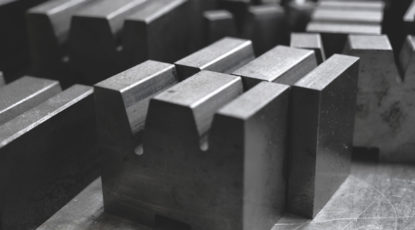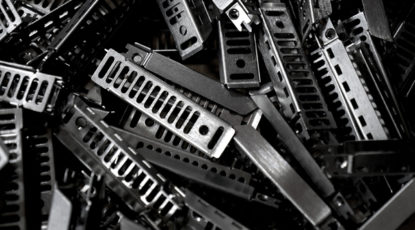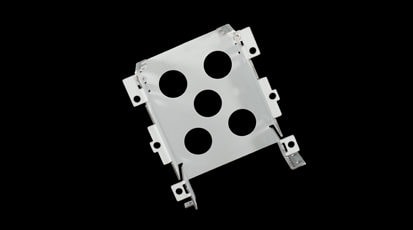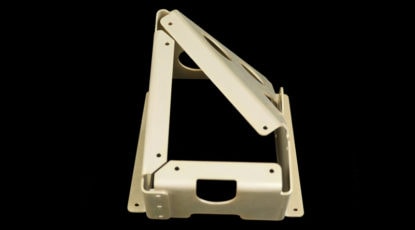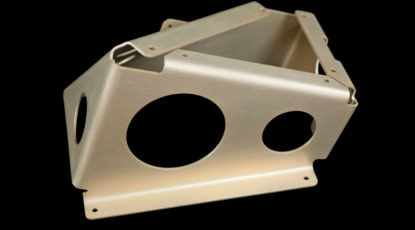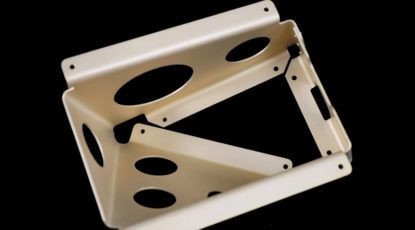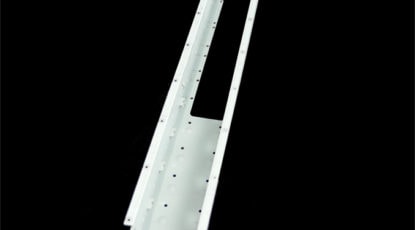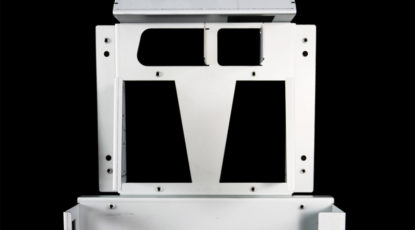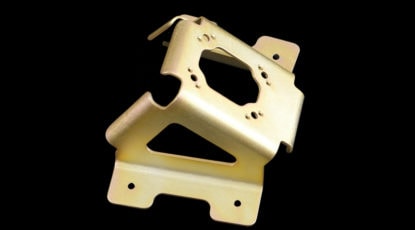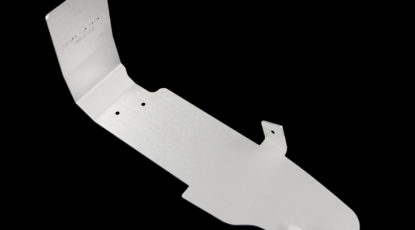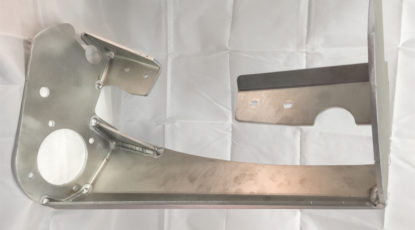Sheet Metal Fabrication
At CNC Machining Hong Kong, Incorporated, we specialize in complete manufacturing solutions. Equipped with over five decades of industry experience and a state-of-the-art facility, our team has the knowledge, skills, and tools to provide a broad selection of custom sheet metal fabrication services. Below we provide a more comprehensive overview of our sheet metal fabrication capabilities.
What Is Sheet Metal Fabrication?
Sheet metal fabrication refers to the various metalworking processes—e.g., bending, cutting, forming, rolling, and welding—used to turn sheet metal into the desired parts, products, and structures by removing, deforming, or joining the material. Each process may employ specialized equipment (e.g., the bending process uses press brakes) and can be combined with other processes to meet more complex design specifications. Once the sheet metal undergoes all necessary sheet metal fabrication requirements, it is generally subjected to finishing techniques (e.g., sanding blasting, priming, and painting) to improve the functional and aesthetic qualities.
Below we provide a brief explanation of some of the most commonly used sheet metal fabrication processes.
Applications of the Sheet Metal Fabrication Process
Sheet metal fabrication operations create elements that find use in a wide range of applications. The strength, durability, and cost-effectiveness offered by fabricated metal parts makes them highly suitable for virtually every industry, including, but not limited to, the following:
- Aerospace and aviation
- Appliances
- Automotive
- Chemical
- Construction
- Consumer goods
- Electronics
- Energy generation and distribution
- Hardware
- Marine
- Manufacturing
- Medical and dental
- Military
- Mining
- Oil and gas
- Piping
- Tools
- Transportation
Some examples of typical sheet metal fabricated industrial components include:
- Automobile parts (e.g., bodies and engines)
- Containers (e.g., barrels and cans)
- Electrical and electronic parts (e.g., wires and piping)
- Enclosures and housings
- Energy equipment (e.g., generator parts and power lines)
- Equipment hardware (e.g., brackets and handles)
- Medical equipment (e.g., patient handling devices and surgical instruments)
- Tools (e.g., hammers and saws) and fasteners (e.g., bolts and screws)
Common Materials Used for Sheet Metal Fabrication
Sheet metal fabrication processes accommodate a variety of metal materials. The metal employed—as well as the part and production specifications—largely determines which process or processes are most appropriate for the project. In turn, the ideal material depends on the part and production specifications and the intended use of the finished component. For example, copper is suitable for applications requiring electrical conductivity, while stainless steel is an appropriate option for environments involving corrosive compounds.
At CNC Machining Hong Kong, some of the metals that we regularly use in our sheet metal fabrication operations include:
- Aluminum
- Brass
- Bronze
- Copper
- Nickel
- Stainless steel (303, 304, 316, 15-5, and 17-4)
- Steel and steel alloys
- Titanium
We also offer fabrication capabilities for non-metallic substrates, such as acetal, acrylic, nylon, polycarbonate, composites (e.g., G-10), and fiberglass-reinforced plastics (FRP).
How to Choose a Material for a Sheet Metal Fabrication Operation
As indicated above, the best metal to use in a sheet metal fabrication operation depends on the project and application requirements. While a consultation with one of our experts can help customers identify and select the most appropriate material for their part, product, or structure, the following descriptions of common sheet metals may help narrow the selection of suitable options.
- Aluminum: Aluminum is a lightweight and corrosion resistant material. While it is decently strong, it is often alloyed with other metals and compounds to add or enhance certain properties to improve its performance in industrial environments. It is used for a variety of industrial compounds, ranging from consumer electronics (e.g., laptops, smartphones, tablets, and telephones) to buildings (both residential and industrial) to transportation equipment (e.g., airplane parts and motors).
- Brass: Brass is an alloy consisting of copper and zinc. It is known for its strength and low weight (compared to copper and other copper alloys), as well as its corrosion resistance and attractive coloring. It is used for both functional and decorative components.
- Copper: Copper is a highly conductive, corrosion resistant, and workable material. For these reasons, it is often used in the manufacture of electrical and electronic parts. Its distinct color also makes it popular for decorative components such as jewelry.
- Stainless steel: Stainless steel is an alloy of iron, chromium, nickel, and varying levels of other metals (depending on the grade). The presence of chromium gives the material its characteristic corrosion resistance, which makes it highly suitable for environments exposed to the elements and corrosive compounds. Its strength, workability, and low maintenance requirements also suit it for use in a variety of industrial applications, ranging from kitchen appliances to automobile parts to surgical and dental instruments.
- Steel: In addition to stainless steel, steel is available in many other formulations and grades. All of which generally demonstrate high strength and durability, as well as other distinct properties depending on the exact composition. Processing the raw material—such as by hot rolling, cold rolling, or galvanizing it—can alter certain properties to improve the physical performance or finish. Applications range from art and appliances to industrial assemblies, equipment, and structures.
- Titanium: Titanium is renowned for its strength-to-weight ratio, which makes it highly suitable for even the most demanding industrial environments. Combined with its corrosion resistance and durability, this quality makes it a popular construction material for products used in the aerospace, marine, and military industries.
Our Sheet Metal Fabrication Capabilities
Our team offers a broad selection of sheet metal fabrication services: forming, laser cutting, punching, rolling, shearing, and stamping. We maintain an extensive in-house fleet of state-of-the-art metalworking equipment to fulfill customer requests for these processes, including:
- For forming: 4’-10’ CNC Press Brakes & Robotic Bending Cell
- For laser cutting: CO2 and fiber laser cutters
- For punching and stamping: 33-Ton electric turret punch
- For rolling: 5-foot roller
- For shearing: 10-foot shear
These units have the capabilities for manual, CNC, and robotic load/unload operations. Additionally, they allow us to accommodate metal sheets up to 5 feet by 10 feet in a variety of materials (as noted above) to tolerances of ±.003 inches (for holes) and ±.005 to .015 inches (for bends). Our production volume capabilities include prototype, low to high volume, and blanket orders with lead times quoted on a job-by-job basis. Expedited services are also available upon request. Specific process limits are outlined below.
- Laser cutting:Our CO2 and fiber laser cutters allow us to form precise and accurate cuts along two axes in materials ranging from .01 inch to 1 inch in thickness.
- Punching:Our electric turret punch machines are armed with in-turret forming units and live tooling, which allow us to process materials up to 4 feet by 12 feet in size with precision and accuracy.
In addition to our sheet metal fabrication capabilities, we offer precision machine work, welding (including MIG, TIG, and spot welding), and finishing services (e.g., painting, assembly, silkscreen, laser etching, and hardware installation).
Sheet Metal Forming
Sheet metal forming is an effective method for producing sheet metal parts in complex three-dimensional shapes using minimal material. The desired shape is achieved through plastic deformation, without the need for machining. There are two major categories of sheet metal forming: hot and cold forming. Hot forming is when the raw material is manipulated into shape while in a partially liquefied state, this can be achieved through localized heat from a torch, heated tooling, or specialized ovens. This becomes more necessary with thicker materials and more complex shapes. Cold forming is when metal is formed at/near room temperature through use of high tonnage presses and standardized tooling. This is more applicable to thinner materials and less organic shapes.As is the case in many industries, robotics have been applied to sheet metal forming as a way to increase overall productivity but also to cut down on some of the upfront tooling costs seen in other fabrication methods such as stamping.
Sheet Metal Stamping
Sheet metal stamping is a forming process that creates three-dimensional shapes through permanent deformation. It employs a mechanical or hydraulic press and a custom designed punch and die set to create stamped parts and is suitable for producing large quantities of high precision metal parts at low costs. However, initial set up costs are often very high and tooling life and maintenance can often lead to hidden costs.Sheet metal stamping is often used to create metal parts used in the automotive, household appliances, and medical industries.
Sheet Metal Punching
Similar to stamping, sheet metal punching uses heavy machinery and a punch and die assembly to put holes or indents into pieces of sheet metal. As the machine forces the punch component through the metal, it causes the metal underneath the punch to be separated from the rest of the sheet. The cut metal is then collected in a container and saved for future use or recycling. Punching was the primary method for CNC sheet metal cutting for many years before the development of water and laser cutting tools and still specializes in high speed hole application and low-consumable production costs.It can be used to create specific shapes and designs in finished parts and components, such as vent openings.
Sheet Metal Rolling
Sheet metal rolling passes the metal through three rollers to shorten one face of the material and elongate the opposite face causing a progressive curvature in the sheet. This can be done to create complete tubes or to roll to a specific profile. More advanced rolling machines are able to form extremely complex tangential profiles with precision and repeatability. Some products that can be made using this process include lock-seam pipes, welded pipes, and open-butt-joint pipes.
Sheet Metal Laser Cutting
Laser cutting directs a high-powered laser through optical components to cut sheet metal into custom shapes and designs for industrial and commercial applications. Compared to similar processes, such as plasma cutting, it is more precise and uses less energy, and is suitable for cutting and engraving a variety of metals, including aluminum, copper, and steel. For thicker material you may need to utilize water jet cutting as most laser cutters are not suitable above 1” thick material.
Sheet Metal Shearing
Shearing employs a set of upper and lower straight-edge blades to cut flat metal stock—such as aluminum, brass, bronze, and stainless steel—into separate pieces. The blades are typically offset from each other with the upper blade angled to facilitate the cutting operation. This process is usually used to cut sheet metal into smaller sizes to prepare it for further processing, rapid prototyping of very simple parts, or commonly in A/C duct manufacturing.
Conclusion
There are many different techniques used in sheet metal fabrication, including stamping, punching, rolling, and shearing. Each technique has a distinct purpose and is used to create different shapes and components, which often require additional finishing and treatment processes following fabrication.CNC Machining Hong Kong Inc. has been committed to providing customers with precision sheet metal fabrication services since 1969. Our team has the experience and expertise needed to get your job done properly and promptly. These qualities, combined with some of the most advanced metal fabrication equipment around, allow us to provide you with exceptional quality at low prices.
Since 1969, CNC Machining Hong Kong, Incorporated has been committed to providing precision sheet metal fabrication services that set the standard in the DC Metro for quality and value. Our staff of industry professionals are skilled craftsmen with decades of broad-based metal fabrication experience. When combined with some of the most advanced metal fabrication equipment available, we can offer unmatched process flexibility and value. From forming and shearing to punching, rolling, stamping, and laser cutting, we have the capabilities to accommodate the most stringent requirements. Our facility is equipped with CNC punches with 4’ x 12’ capacity featuring in-turret forming and live tooling. Our shear can cut material up to ¼” in thickness and up to 10’ in length, and we can roll sheets up to 5’ in width and ¼” in thickness. We also operate a number of high precision CNC brakes that allow us to provide high accuracy forming regardless of quantity or geometric complexity up to 10’ in length.
Another productivity enhancing resource is our brand new 6000W Mitsubishi Fiber Laser. This state of the art cutting system utilizes flying optics, can accommodate material up to 5’ x 10’, and provides clean cuts, narrow kerfs, at high speed on material from .01” up to 1” in thickness. Equipped with an automatic pallet changer, it is suited for long runs as well as single part production. All of our CNC systems are supported by CAD/CAM capabilities, which allow for faster set ups with enhanced productivity. As an ISO 9001:2015 registered organization, quality is part of our culture; our team is dedicated to upholding quality and maintaining low-cost production.
Contact CNC Machining Hong Kong for Sheet Metal Fabrication Services
Sheet metal fabrication processes play a critical role in the industrial, commercial, and defense sectors. Many of the part, products, and structures used throughout regular and professional activities have some element that is fabricated from sheet metal. For customers looking for a sheet metal fabrication partner, CNC Machining Hong Kong is an ideal choice.
At CNC Machining Hong Kong, we have extensive experience providing complete manufacturing solutions, including sheet metal fabrication, machining, assembly, and finishing. To learn more about our capabilities or partner with us on your next project, contact us or request a quote today.
Sheet Metal Fabrication Specifications
- Fabrication Process
-
Forming
Laser Cutting
PunchingRolling
Shearing
Stamping
- Automation Capabilities
-
CNC
Manual
Robotic Load/Unload
- Laser Cutting
-
CO2 (Gaseous)
Fiber
- Laser Configuration
-
Flying Optics
5’ x 10’ Capacity
Thickness: .01” to 1”
- Punch Configuration
-
4’ x 12’ Capacity
In-turret Forming
Live Tooling
- Cutting Axis
-
2-Axis
- Materials
-
Aluminum
Steel
Stainless Steel (303, 304, 316, 15-5 and 17-4)
Acetal / Delrin
Nylon
Composites (G-10, etc.)
Alloy Steels
Aluminum
Brass
Bronze Alloys
Carbide
Carbon SteelCobalt
Copper
Iron
Nickel
Stainless Steel
Tin
Titanium
Acetal
Acrylic
Fiberglass Reinforced Plastics
Polycarbonate
- Raw Material Forms
-
Sheet
- Maximum Sheet Metal Dimensions
-
5’ x 10’
- Tolerance (+/-)
-
Hole: .002”
Bend: .005” to .015”
- Additional Services Provided
-
Precision Sheet Metal Fabrication
Precision Machine WorkWelding MIG, TIG & Spot Welding
Painting, Assembly & Hardware
- Equipment List
-
CO2 Laser
Fiber Laser
Electric Turret Punch
10’ Press BrakeElectric Turret Punch
10’ Press Brake 10’ Sheer
5’ Sheet Roll
Manual Forming
- Production Volume
-
Prototype
Low VolumeHigh Volume
Blanket Orders
- Lead Times
-
Quoted on job by job basis
Expedited Services Available
Additional Information
- Industries Focus
-
Aerospace
Electronic
Architectural
ChemicalDental
Marine
Medical
Military
- Industry Standards
-
ANSI
American National Standards Institute
ASME
American Society of Mechanical Engineers
ASTM
American Society for Testing and Materials
AWS
American Welding Society
Calibrated/Certified Inspection Tools and Equipment
ISO 9001:2015 (FM 96437)
International Organization for Standardization
Iridite / Chem Film Per MIL-C-5541 F
Mil-Spec
Military Specifications- MIL-SPEC 1595
- MIL-SPEC W68581
RoHS
Restriction Of Hazardous Substances (Compliant)
- File Formats
-
AutoCAD (DWG, DWZ)
BMP
Bit Mapped Graphics
Catia (CATDrawing, CATPart)
DXF
Drawing Interchange Format, or Drawing Exchange Format
GIF
Graphics Interchange Format
IGES
Initial Graphics Exchange Specification, ANSI file format.
Inventor (IDW, IPT)
JPG or JPEG
Joint Photographic Experts Group
Merry Mech
MasterCam (MDX, MC8, MC9, SET, MX7)
PDES
Product Data Exchange using STEP, Standard for the Exchange of Product Model Data. A standard format for exchanging data between advanced CAD and CAM programs.
PDF
Portable Document Format
Pro-E or Pro/Engineer (DRW, PRT, XPR)
SAT
3D ACIS Model File
SolidEdge (DFT)
SolidWorks (SLDPRT, SLDDRW, SLDDRT)
STEP
Standard for the Exchange of Product Model Data
TIFF
Tagged Image File Format
Unigraphics (PRT)


